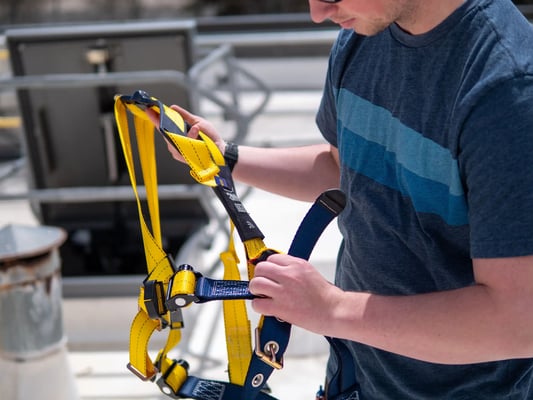
Understanding the Differences in Harnesses, Lanyards, and Hardware Styles
Every safety professional and at-height worker understands the importance of wearing a safety harness. But harnesses and connecting devices come in many different styles and options that can make choosing the right one difficult. This article will explain the differences between the most common styles of harnesses and connecting devices to help you determine which best suits your application.
Harness Styles
A full-body harness is the foundation of any fall protection system. Different styles are available to suit various applications, ensuring comfort and practicality for workers.
- Vest Harness: This is the most commonly used harness on job sites due to its versatility and ease of use.
- Crossover Harness: Features a sternal D-ring that allows for greater arm movement, often used with ladder climbing systems.
- Suspension Harness: Designed for rope access and rescue applications, these harnesses have leg straps that distribute weight evenly to prevent suspension trauma.
- Construction Harness: Manufactured with lightweight materials that enhance comfort and freedom of movement while maintaining maximum protection.
Buckle Styles
A harness must be securely fastened to function properly. Different buckle styles offer various levels of ease of use and security:
- Pass-through Buckle: Uses two metal plates that interlock to create a firm connection.
- Tongue and Grommet Buckle: Similar to a standard belt buckle, this connection style allows for quick and secure fastening.
- Quick-Connect Buckle: The easiest to use, similar to the buckle on a seatbelt, providing a fast and secure connection.
Harness Applications: Matching the Harness to the Task
Selecting the right harness depends on the specific application and type of work being performed. Here are common harness applications:
- Fall Arrest: Features a dorsal D-ring used with personal fall arrest systems to prevent a worker from hitting the ground in the event of a fall.
- Descent Control: Includes a rescue D-ring designed for use with descent control devices, offering a stable connection point for controlled lowering.
- Ladder Climbing: Incorporates a sternal D-ring, used for rigid ladder safety systems, positioned off-center to prevent facial injuries during a fall.
- Confined Entry/ Retrieval: Equipped with shoulder D-rings to facilitate vertical entry and retrieval in confined spaces.
- Work Positioning: Features hip D-rings for use with pole straps or work positioning lanyards to provide stability during tasks that require hands-free operation.
Lanyards: The Critical Link in Fall Protection
Lanyards serve as a connection between the harness and an anchor point, helping absorb fall impact and reduce injury risks. The type of lanyard chosen depends on the work environment and specific application:
- Webbing Lanyard: The most common material, durable and resistant to rough use and exposure to the elements.
- Steel Cable Lanyard: Offers enhanced strength and is best suited for high-heat environments or areas requiring extra edge protection.
- Stretch Lanyard: Expands and contracts with the user's movement, reducing tripping hazards and the risk of snagging.
- Twin-Leg Lanyard: Features two connection points, allowing workers to stay tied off at all times while moving from one anchor point to another.
Hardware: Essential Connectors for Fall Protection Systems
Hardware components are crucial for safely connecting different parts of a fall protection system. The best fall protection hardware should always have a self-closing, auto-locking gate for maximum security:
- Snaphook: A hook device with a locking mechanism used to attach a harness to a fall protection or rescue component. It includes a captive eye that prevents accidental disengagement.
- Carabiner: A versatile connector that can be used independently since it is not permanently affixed to a specific component. Carabiners are ideal for custom fall protection setups.
- Scaffold Hook: Similar to a snaphook but with a larger gate, making it easier to attach to scaffolding or other large anchor points, providing secure connections in construction and industrial settings.
Conclusion: Selecting the Right Fall Protection Equipment
Understanding the different types of harnesses, buckles, applications, lanyards, and hardware is critical for creating a comprehensive fall protection system. Choosing the right equipment depends on the specific job requirements, work environment, and safety regulations. Whether you need a harness for fall arrest, ladder climbing, or work positioning, selecting the right components ensures maximum safety and efficiency for workers at height.
By investing in high-quality fall protection equipment, companies can reduce workplace accidents, comply with safety standards, and create a secure working environment for their employees.
Schedule an assessment with Diversified Fall Protection
Contact Us to request a fall safety review

b-1.jpg?width=1368&height=1340&name=Rail%20(175)b-1.jpg)

